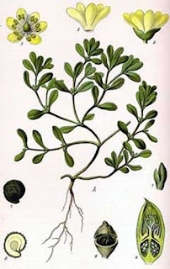
Nandina
Nandina is naturalized in my region. I think it is a very pretty plant, with attractive foliage and bright red berries. But, many consider it a weed. It is strongly medicinal, but the berries are poisonous and all parts of the plant contain some toxicity.
Plants for A Future states:
Medicinal use of Sacred Bamboo: The roots and stems are antitussive, astringent, febrifuge, stomachic and tonic. A decoction is used in the treatment of fever in influenza, acute bronchitis, whooping cough, indigestion, acute gastro-enteritis, tooth abscess, pain in the bones and muscles and traumatic injuries. It is especially useful in the treatment of children's coughs. There is a danger that an overdose can cause respiratory paralysis. A decoction of the leaves is tonic. The fruit is febrifuge and tonic. Another report says that it is toxic, so great care should be employed if using it. The root is antirheumatic. Young shoots contain high concentrations of laetrile - up to 20% on a zero moisture basis.

Opuntia, Prickly Pear Cactus
Twelve varieties of Opuntia have documented use in Herbal Medicine: Opuntia compressa - Eastern Prickly Pear, Opuntia erinacea - Mojave Prickly Pear, Opuntia ficus-indica - Prickly Pear, Opuntia fragilis - Prickly Pear, Opuntia howeyi, Opuntia imbricata - Tree Chola, Opuntia littoralis - Western Prickly Pear, Opuntia macrorhiza - Twist-Spine Prickly Pear, Opuntia microdasys - Bunny Ears, Opuntia phaeacantha - Bastard Fig, Opuntia polyacantha - Plains Prickly Pear, Opuntia ramosissima - Branched Pencil Cholla
Three are native to my region: Opuntia humifusa var. humifusa (Eastern Prickly-pear), Opuntia pusilla (Dune Prickly-pear), Opuntia stricta var. stricta (Erect Prickly-pear), and Opuntia ficus-indica (Indian Fig) is often grown ornamentally. Opuntia monacantha (Common Prickly-pear) is naturalized.
These cacti were a very important source of food for Native Americans and early settlers. Wherever you see a large stand of Prickly Pear, it is a likely sign that a family once lived there. The pads are used mostly in Mexican and South American cuisine, while the fruits were used more in my region. The fruits are somewhat like mildly flavored, seedy kiwis…. AFTER you burn off the cactus spines! I often harvest these by simply cutting them into a bucket with a long knife, then burning the spines off at home with a plumber’s torch and a pair of tongs. The pads, despined and split, make excellent poultices for wounds and even serious venomous bites.
Resources of The Southern Fields and Forests tells us:
CACTUS; PRICKLY PEAR, (Opuntia vulgaris, Mill. T. and Gray. Cactus opuntia of Ell. Sk.) Grows in dry pastures ; Newbern. Fl. May.
Mer. and de L. Diet, de M. Med. vi, 11.
The fruit is said to be eatable ; the leaves cut transversely are applied to tumors as a discutient; the decoction is mucilaginous, and I am informed that it is much used in Alabama as a demulcent drink in pneumonic and pleuritic inflammations.
Botany In A Day tells us:
Medicinally the pads are very similar to Aloe vera and like Aloe, the Opuntia poultice osmotically draws out waste material from bruised, burned or other injured tissue, while soothing those tissues with its mucilaginous property. A similar mucopolysaccharide forms a “hydrogel” between your body’s cells. This gel can dry out and break and break down after an injury, especially from a burn or sunburn. Your body will absorb the mucilage out of a cactus pad to strengthen your own mucopolysaccharide gel. Wipe a cactus pad over the burn and you will feel how quickly the mucilage is absorbed into the skin. Keep rubbing in fresh mucilage and you can recover from many otherwise serious burns.
Prickly pear has a hypoglycemic effect for adult-onset diabetes. The effective dose averaged 4 ounces of juice per day. Refer to Michael Moore’s Medicinal Plants of the Desert and Canyon West for more information.
Plants for A Future states:
Medicinal use of Eastern Prickly Pear: A poultice of the peeled pads is applied to wounds, sores etc. The juice of the fruits is used as a treatment for warts. A tea made from the pads is used in the treatment of lung ailments.
Medicinal use of Prickly Pear: The flowers and stems are antispasmodic, diuretic and emollient. The split stems have been bound around injured limbs as a first aid measure. The flowers are astringent and are used to reduce bleeding and treat problems of the gastro-intestinal tract, especially diarrhoea, colitis and irritable bowel syndrome. The flowers are also used in the treatment of an enlarged prostate gland.
Peterson Field Guides Eastern/Central Medicinal Plants tells us:
American Indians poulticed peeled pads on wounds, applied juice of fruits for warts; drank pad tea for lung ailments. In folk medicine, peeled pads used for rheumatism; juice used for “gravel” (kidney stones; baked pads used for gout, chronic ulcers and wounds.
This article is an excerpt from
Medicinal Shrubs and Woody Vines of The American Southeast An Herbalist's Guide
Read about Medicinal Shrubs and Woody Vines of The American Southeast An Herbalist's Guide:
https://southernappalachianherbs.blogspot.com/2022/06/medicinal-shrubs-and-woody-vines-of.html
Available for purchase on Amazon:
https://www.amazon.com/dp/B0B2T4Y5L6: by Judson Carroll
PS. New today in my Woodcraft shop:
https://judsoncarrollwoodcraft.substack.com/p/wild-cherry-salad-set-1
New Book: A Daily Catholic Devotional Reflections on the Daily Mass readings January-June, 2024
https://southernappalachianherbs.blogspot.com/2023/12/a-daily-catholic-devotional-reflections.html
Read about my other new books:
Medicinal Weeds and Grasses of the American Southeast, an Herbalist's Guide
https://southernappalachianherbs.blogspot.com/2023/05/medicinal-weeds-and-grasses-of-american.html
Available in paperback on Amazon:
https://www.amazon.com/dp/B0C47LHTTH
and
Confirmation, an Autobiography of Faith
https://southernappalachianherbs.blogspot.com/2023/05/confirmation-autobiography-of-faith.html
Available in paperback on Amazon:
https://www.amazon.com/dp/B0C47Q1JNK
Visit my Substack and sign up for my free newsletter:
https://judsoncarroll.substack.com/
Read about my new other books:
Medicinal Ferns and Fern Allies, an Herbalist's Guide
https://southernappalachianherbs.blogspot.com/2022/11/medicinal-ferns-and-fern-allies.html
Available for purchase on Amazon:
https://www.amazon.com/dp/B0BMSZSJPS
The Omnivore’s Guide to Home Cooking for Preppers, Homesteaders, Permaculture People and Everyone Else:
https://southernappalachianherbs.blogspot.com/2022/10/the-omnivores-guide-to-home-cooking-for.html
Available for purchase on Amazon:
https://www.amazon.com/dp/B0BGKX37Q2
Medicinal Shrubs and Woody Vines of The American Southeast an Herbalist's Guide
https://southernappalachianherbs.blogspot.com/2022/06/medicinal-shrubs-and-woody-vines-of.html
Available for purchase on Amazon
https://www.amazon.com/dp/B0B2T4Y5L6
and
Growing Your Survival Herb Garden for Preppers, Homesteaders and Everyone Else
https://southernappalachianherbs.blogspot.com/2022/04/growing-your-survival-herb-garden-for.html
https://www.amazon.com/dp/B09X4LYV9R
The Encyclopedia of Medicinal Bitter Herbs:
https://southernappalachianherbs.blogspot.com/2022/03/the-encyclopedia-of-bitter-medicina.html
Available for purchase on Amazon:
https://www.amazon.com/dp/B0B5MYJ35R
and
Christian Medicine, History and Practice:
https://southernappalachianherbs.blogspot.com/2022/01/christian-herbal-medicine-history-and.html
Available for purchase on Amazon: www.amazon.com/dp/B09P7RNCTB
Herbal Medicine for Preppers, Homesteaders and Permaculture People:
https://southernappalachianherbs.blogspot.com/2021/10/herbal-medicine-for-preppers.html
Also available on Amazon: www.amazon.com/dp/B09HMWXL25
Podcast:
https://www.spreaker.com/show/southern-appalachian-herbs
Blog:
https://southernappalachianherbs.blogspot.com/
Free Video Lessons:
https://rumble.com/c/c-618325
Disclaimer
The information on this site is not intended to diagnose or treat any disease or condition. Nothing on this site has been evaluated or approved by the FDA. I am not a doctor. The US government does not recognize the practice of herbal medicine and their is no governing body regulating herbalists. Therefore, I'm just a guy who studies herbs. I am not offering any advice. I won't even claim that anything I write is accurate or true! I can tell you what herbs have "traditionally been used for." I can tell you my own experience and if I believe an herb helped me. I cannot, nor would I tell you to do the same. If you use any herb I, or anyone else, mentions you are treating yourself. You take full responsibility for your health. Humans are individuals and no two are identical. What works for me may not work for you. You may have an allergy, sensitivity or underlying condition that no one else shares and you don't even know about. Be careful with your health. By continuing to read my blog you agree to be responsible for yourself, do your own research, make your own choices and not to blame me for anything, ever.






















